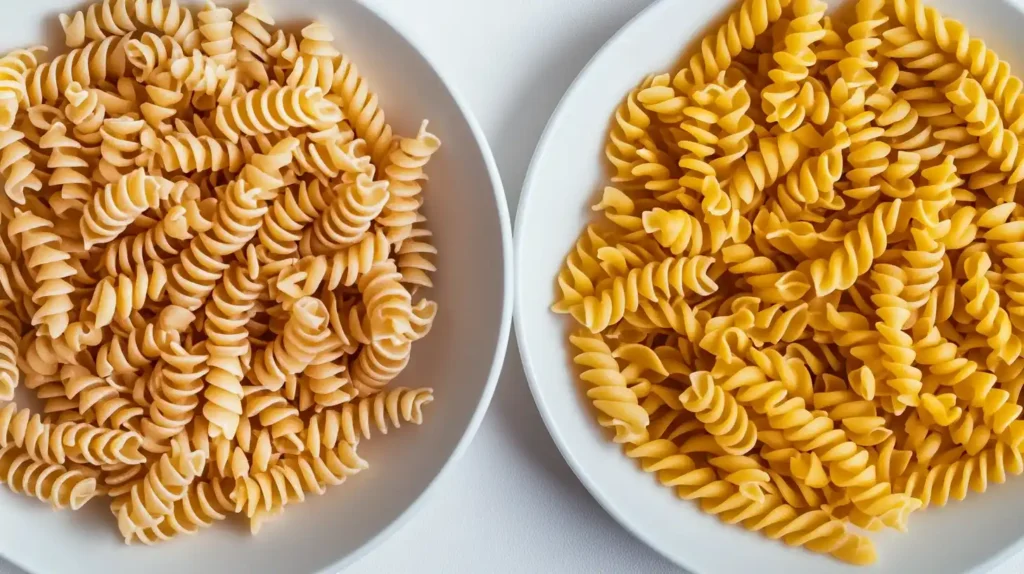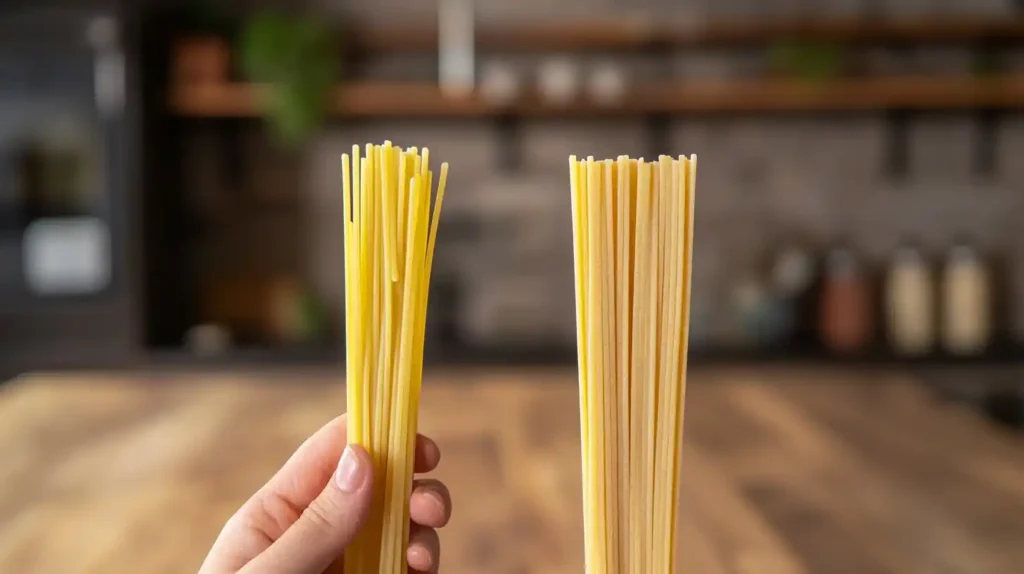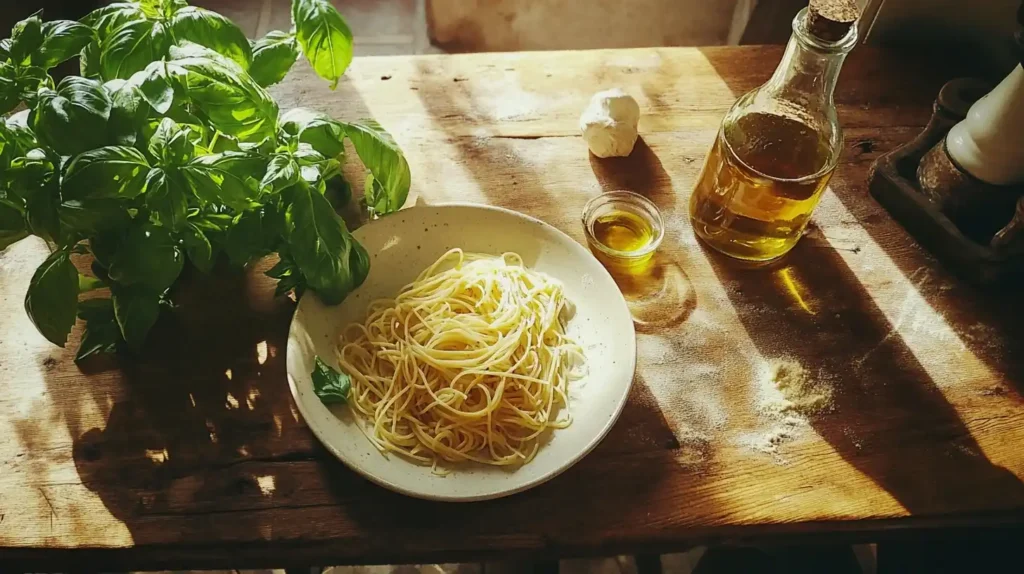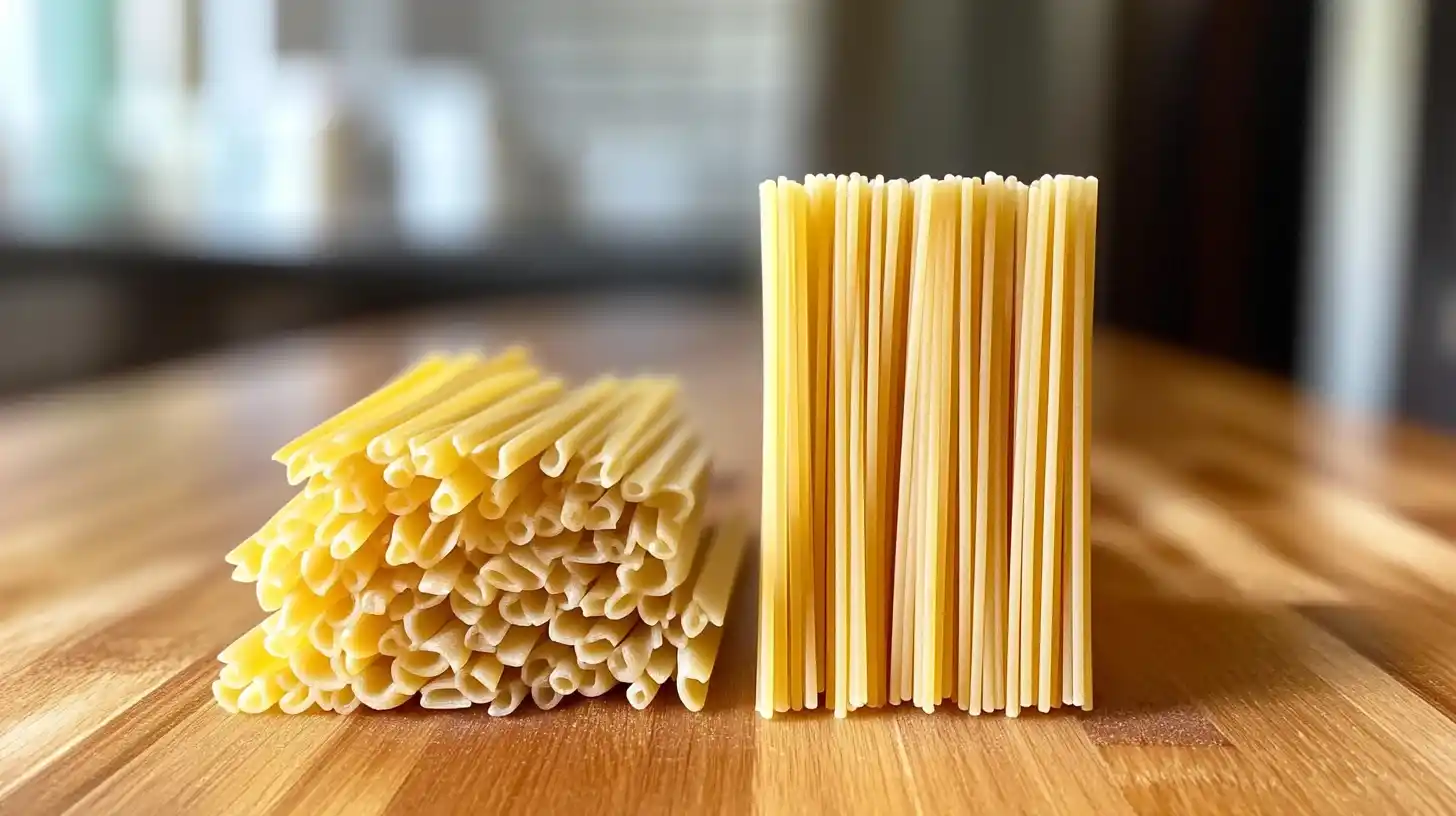Is linguini or fettuccini thinner? This common question often arises when cooking Italian dishes, as the thickness of the pasta affects how it pairs with sauces, cooks, and even tastes. Whether you’re a pasta enthusiast or new to cooking, understanding the difference between linguini and fettuccini is key to creating the perfect dish.
Understanding the difference can help you choose the right pasta for your recipes. Plus, knowing more about pasta makes cooking more fun and your meals even tastier. Let’s dive into the details to see how linguini and fettuccini compare.

Table of contents
- What is Linguini? (linguini vs fettuccini, linguini or fettuccini differences)
- What is Fettuccini? (linguini vs fettuccini, fettuccini width)
- Which is Thinner: Linguini or Fettuccini? (linguini thickness, linguini vs fettuccini)
- How to Choose the Right Pasta for Your Dish (linguini vs fettuccini)
- FAQs About Linguini and Fettuccini
- Conclusion
What is Linguini? (linguini vs fettuccini, linguini or fettuccini differences)
Linguini is a thin, flat pasta often associated with light and flavorful dishes. If you’re wondering, is linguini or fettuccini thinner, the answer starts here: linguini is the narrower option. It is ideal for delicate sauces, such as:
- Pesto: Its flat shape holds just the right amount of sauce.
- Seafood-based sauces: Perfect for recipes like linguini with clam sauce.
By pairing light sauces with linguini, you can enhance its delicate texture. Curious about how linguini stacks up against similar pastas? Check out this guide to spaghettini recipes for more inspiration.
Why is Linguini Special? (linguini or fettuccini differences)
Here are some features that make linguini stand out:
- Thin and delicate: Linguini has a smooth, flat texture that holds sauces well without being too heavy.
- Perfect for light dishes: It works best with simple sauces, like olive oil, marinara, or seafood-based sauces, because its thin shape lets the flavors shine.
- Quick cooking: Because it’s thinner than fettuccini, it cooks faster, usually in about 7-9 minutes.
Popular Uses for Linguini (linguini vs fettuccini)
- Seafood dishes: For example, linguini with clam sauce is a classic Italian favorite.
- Herb-based sauces: Pesto clings well to the flat surface of linguini.
- Vegetarian options: Linguini works beautifully with light tomato or lemon-based sauces.
What is Fettuccini? (linguini vs fettuccini, fettuccini width)
Linguini is a thin, flat pasta often associated with light and flavorful dishes. If you’re wondering, is linguini or fettuccini thinner, the answer starts here: linguini is the narrower option. It is ideal for delicate sauces, such as:
- Pesto: Its flat shape holds just the right amount of sauce.
- Seafood-based sauces: Perfect for recipes like linguini with clam sauce.
Characteristics of Fettuccini
- Wide and flat: With its ribbon-like shape, fettuccini can hold thick sauces effortlessly.
- Hearty texture: Its sturdy structure makes it great for dishes that need pasta with a bit of chew.
- Versatile: It can be used in both traditional Italian meals and fusion recipes.
Why is Fettuccini Popular?
Here’s why chefs and home cooks love fettuccini:
- Perfect for creamy sauces: Thick, rich sauces like Alfredo and carbonara cling to its wide surface, ensuring every bite is flavorful.
- Ideal for slow-cooked sauces: Meat-based ragù or mushroom cream sauce pairs beautifully with fettuccini.
- Comfort food favorite: It is a go-to for hearty, filling meals that warm the soul.
Cooking Fettuccini (pasta thickness comparison)
Fettuccini is slightly thicker than linguini, so it takes longer to cook—around 10-12 minutes. Once cooked, it retains its structure and remains firm, which is perfect for holding heavy sauces.
Which is Thinner: Linguini or Fettuccini? (linguini thickness, linguini vs fettuccini)
To answer the question, is linguini or fettuccini thinner, we need to compare their dimensions:
- Linguini: Narrow and flat, about 3-4 millimeters wide.
- Fettuccini: Wider and thicker, measuring around 6-7 millimeters.
The thinner linguini works well with light sauces, while fettuccini is better for rich, heavy flavors.
Thickness Comparison
- Linguini: This pasta is thinner and narrower, measuring about 3-4 millimeters wide. Its slender shape makes it delicate and perfect for light dishes.
- Fettuccini: This pasta is wider and thicker, typically around 6-7 millimeters wide. Its robust build is better suited for hearty, rich meals.
Why Does Thickness Matter?
The thickness of the pasta affects several factors:
- Cooking Time
- Linguini: Because it is thinner, it cooks faster, typically in 7-9 minutes.
- Fettuccini: Its thicker shape takes longer to cook, around 10-12 minutes.
- Texture and Bite
- Linguini: Offers a softer, lighter bite, ideal for dishes with subtle flavors.
- Fettuccini: Provides a firmer, chewier texture, perfect for standing up to heavier sauces.
- Sauce Pairing
- Linguini: Works well with lighter sauces like pesto, olive oil, or seafood.
- Fettuccini: Best paired with creamy, cheese-based, or meat-heavy sauces.

Visualizing the Difference
Think of linguini as the elegant, slim cousin of fettuccini. While linguini dances gracefully with light sauces, fettuccini is the sturdy choice for bold, rich flavors. Together, they offer versatility and variety in your kitchen.
Cooking and Texture
- Linguini is softer and lighter because it is thinner.
- Fettuccini has a chewy texture that feels heavier in the mouth.
This makes linguini better for lighter meals and fettuccini ideal for hearty dishes.
How to Choose the Right Pasta for Your Dish (linguini vs fettuccini)
Deciding between linguini and fettuccini comes down to the type of dish you want to create. Both pastas have unique qualities that make them ideal for different recipes. Here’s a simple guide to help you choose.
When to Use Linguini
Is linguini or fettuccini thinner? Linguini is a versatile pasta that works beautifully in light, flavorful dishes. Its thin and flat shape makes it ideal for recipes that don’t rely on heavy, creamy sauces but instead highlight delicate ingredients. When considering linguini vs. fettuccini, the key difference is their thickness. Linguini is noticeably thinner than fettuccini, making it better suited for lighter sauces, while fettuccini’s wider shape holds up well to rich, creamy sauces. Here’s a closer look at when and why you should choose linguini for your meal.
Ideal Sauces for Linguini
- Pesto Sauce
- Linguini pairs exceptionally well with pesto because its flat surface holds just the right amount of sauce.
- The light, herbaceous flavor of pesto complements the delicate texture of linguini.
- Marinara Sauce
- The tomato-based marinara sauce clings to linguini without overwhelming its thin structure.
- Perfect for a quick, healthy meal that’s full of flavor but not too heavy.
- Garlic and Olive Oil
- A minimalist sauce like garlic and olive oil (known as aglio e olio) shines with linguini.
- This pairing allows the pasta’s lightness to come through while delivering robust flavor from the garlic and oil.
- Seafood-Based Sauces
- Linguini is often used in seafood dishes because its thin profile complements the delicate textures of shellfish and fish.
- Popular combinations include clam sauce, shrimp scampi, or a light white wine and butter sauce with mussels.
Why Choose Linguini?
- Light and Versatile: Its thin texture makes linguini less filling, which is ideal for dishes where the sauce and toppings are the stars.
- Quick Cooking: Linguini cooks in just 7-9 minutes, making it a convenient option for busy weeknights.
- Elegant Presentation: The long, slender shape of linguini looks beautiful on the plate, adding sophistication to simple dishes.
Example Dishes with Linguini
- Linguini with Lemon and Capers: A refreshing, tangy dish perfect for summer evenings.
- Linguini Primavera: Loaded with fresh vegetables, this is a healthy and colorful option.
- Linguini in Broth: Served in a light broth, linguini transforms into a comforting soup.
When Not to Use Linguini
While linguini is versatile, it’s not the best choice for every dish. Avoid using it with:
- Thick, creamy sauces like Alfredo, which can weigh down the delicate noodles.
- Heavy meat-based ragùs, as the sauce may overpower the pasta’s subtle texture.
When to Use Fettuccini
Is linguini or fettuccini thinner? Fettuccini is a sturdy and hearty pasta that stands up to rich, creamy, and flavorful sauces. Its wide, flat ribbons are designed to hold thick sauces, making it a popular choice for indulgent and satisfying meals. When comparing linguini vs. fettuccini, fettuccini is noticeably thicker and wider, which allows it to handle heavier sauces, while linguini is better suited for lighter, oil-based or seafood dishes. Let’s explore the best ways to use fettuccini and why it’s the perfect pasta for specific dishes.
Ideal Sauces for Fettuccini
- Alfredo Sauce
- Fettuccini Alfredo is a classic Italian-American dish where the pasta’s broad surface holds the creamy, cheese-based sauce perfectly.
- The richness of Alfredo sauce pairs beautifully with the hearty texture of fettuccini.
- Carbonara Sauce
- Made with eggs, Parmesan, pancetta, and black pepper, carbonara clings to fettuccini like a dream.
- The robust pasta provides a firm bite, balancing the rich, velvety sauce.
- Mushroom Cream Sauce
- Earthy mushrooms combined with heavy cream create a luxurious sauce that pairs exceptionally well with fettuccini.
- The wide pasta ribbons ensure you get a perfect sauce-to-pasta ratio in every bite.
- Meat-Based Sauces
- Hearty sauces like beef ragù or Bolognese cling well to fettuccini.
- The pasta’s sturdy structure supports the weight of the meat and sauce without breaking or losing its texture.
Why Choose Fettuccini?
- Holds Heavy Sauces: The wide ribbons of fettuccini are built to carry thick, creamy, or chunky sauces.
- Perfect for Filling Meals: Its robust texture and hearty nature make it an excellent choice for dishes meant to satisfy.
- Versatility with Toppings: From creamy Alfredo to rich meat sauces, fettuccini pairs well with a variety of flavors and ingredients.
Example Dishes with Fettuccini
- Fettuccini Alfredo with Grilled Chicken: A creamy, protein-packed dish that’s easy to make at home.
- Fettuccini with Wild Mushroom Sauce: A luxurious meal with earthy flavors and a touch of cream.
- Fettuccini with Spicy Sausage and Tomato Sauce: Perfect for those who enjoy a bit of heat with their pasta.
When Not to Use Fettuccini
While fettuccini is versatile, it’s not always the best choice. Avoid using it with:
- Light or delicate sauces like olive oil or seafood-based sauces. The wide ribbons may overpower these subtle flavors.
- Cold pasta dishes, as the hearty texture doesn’t lend itself well to light salads or chilled preparations.
Can You Substitute One for the Other?
Yes, you can, but there are a few things to consider:
- Adjust the sauce:
- For linguini, thin the sauce if it’s too heavy to maintain balance.
- For fettuccini, use more sauce to ensure the pasta is well-coated.
- Mind the texture:
- Substituting linguini in a creamy sauce may result in a lighter dish.
- Using fettuccini in a light sauce might feel heavier.
Can You Swap Linguini for Fettuccini?
Tips for Swapping
If you’ve asked yourself, is linguini or fettuccini thinner and wondered if you can substitute them, the answer is yes—but with some adjustments.
- Light Sauces: Use linguini instead of fettuccini to make a dish feel lighter.
- Creamy Sauces: Use fettuccini for creamy recipes, but thin the sauce slightly if you’re using linguini.
- Seafood Dishes: Linguini is traditional for seafood recipes, but fettuccini can provide a heartier twist.
When Can You Swap Them?
- Light Sauces
- If you’re making a dish with light, oil-based, or tomato sauces, linguini can often replace fettuccini.
- The thinner profile of linguini works well with delicate sauces, even in recipes that call for fettuccini.
- Creamy Sauces
- Swapping fettuccini for linguini in creamy sauces like Alfredo can work, but the dish may feel less hearty.
- The thinner linguini may not hold the sauce as well, so consider reducing the sauce’s thickness for better balance.
- Seafood Dishes
- Linguini is traditionally used in seafood dishes, but you can use fettuccini as a substitute for a more robust bite.
- Be mindful that the thicker fettuccini may alter the dish’s texture slightly.
When Should You Avoid Swapping Them?
- Hearty Sauces
- Avoid using linguini in recipes that call for fettuccini with thick sauces, like meat ragù or mushroom cream sauce.
- The delicate structure of linguini can be overpowered, leading to a less satisfying meal.
- Cold or Light Dishes
- Don’t use fettuccini in cold or salad-style pasta dishes, as its thicker texture may feel too heavy.
Tips for Making Substitutions Work
- Adjust Sauce Consistency:
- Thin heavy sauces for linguini to prevent them from overwhelming the pasta.
- Thicken lighter sauces when using fettuccini to ensure they cling to the pasta.
- Consider Cooking Time:
- Linguini cooks faster than fettuccini, so adjust your timing if you’re swapping them.
- Pair with Complementary Ingredients:
- Use lighter toppings and garnishes for linguini substitutions.
- Choose heartier vegetables, meats, or cheeses when using fettuccini.
FAQs About Linguini and Fettuccini
Here are some of the most frequently asked questions about linguini and fettuccini. These answers will help clarify how to use these pastas effectively and enhance your cooking.
1. Which is better for creamy sauces, linguini or fettuccini?
Fettuccini is better for creamy sauces because of its thick, flat ribbons. It holds onto rich sauces like Alfredo or carbonara without getting overwhelmed. Linguini can be used with cream-based sauces but works best with lighter versions to avoid overpowering its delicate texture.
2. Can you use fettuccini in seafood dishes?
Yes, but it’s less common. Seafood dishes often pair with linguini because its thin shape complements the lightness of seafood. If you use fettuccini, choose heartier seafood like shrimp or scallops and a sauce with more body.
3. What’s the main difference between linguini and spaghetti?
Both are long pastas, but linguini is flatter and slightly wider than spaghetti, which is round. Linguini holds sauces better, especially lighter ones, due to its flat surface.
4. How long does it take to cook linguini versus fettuccini?
- Linguini: Cooks in about 7-9 minutes, depending on thickness and brand.
- Fettuccini: Takes 10-12 minutes because it is thicker.
Pro Tip: Always check the pasta package for precise cooking times and taste test for doneness.
5. Can you make both pastas gluten-free?
Yes, both linguini and fettuccini are available in gluten-free versions made from rice, corn, or chickpea flour. Gluten-free pastas often cook faster, so keep an eye on the timing.
6. What’s the best way to store leftover pasta?
Store cooked linguini or fettuccini in an airtight container in the refrigerator for up to 3 days. Add a little olive oil before storing to prevent the noodles from sticking together. Reheat in a pan with a splash of water or sauce to restore texture.
7. Can linguini and fettuccini be used in baked dishes?
Yes, but fettuccini is the better choice for baked dishes due to its sturdy texture. Linguini may overcook and lose its shape in the oven. Consider using fettuccini for casseroles or baked Alfredo recipes.
8. Which pasta is more traditional?
Both are traditional Italian pastas, but linguini has roots in Ligurian cuisine, often paired with pesto. Fettuccini is associated with Roman dishes, such as Fettuccini Alfredo.
Conclusion
When it comes to the question of which pasta is thinner—linguini or fettuccini—the answer is clear: linguini. Its slim, flat shape makes it ideal for light and delicate sauces, while fettuccini’s thick, robust ribbons are perfect for rich, hearty meals. Both pastas are staples in Italian cuisine and offer unique qualities that cater to different tastes and recipes.
- Choose linguini if you’re making dishes with pesto, seafood, or light tomato-based sauces.
- Opt for fettuccini when preparing creamy Alfredo, meat ragù, or mushroom-based sauces.
So, is linguini or fettuccini thinner? The answer is clear: linguini is thinner and perfect for light sauces, while fettuccini is thicker and ideal for rich, creamy dishes. By understanding these differences, you can select the best pasta for your recipes and elevate your Italian cooking.
Now that you know the differences, why not try both in your favorite recipes and see which one becomes your personal favorite? Enjoy your culinary journey, and let the pasta inspire your creativity!


